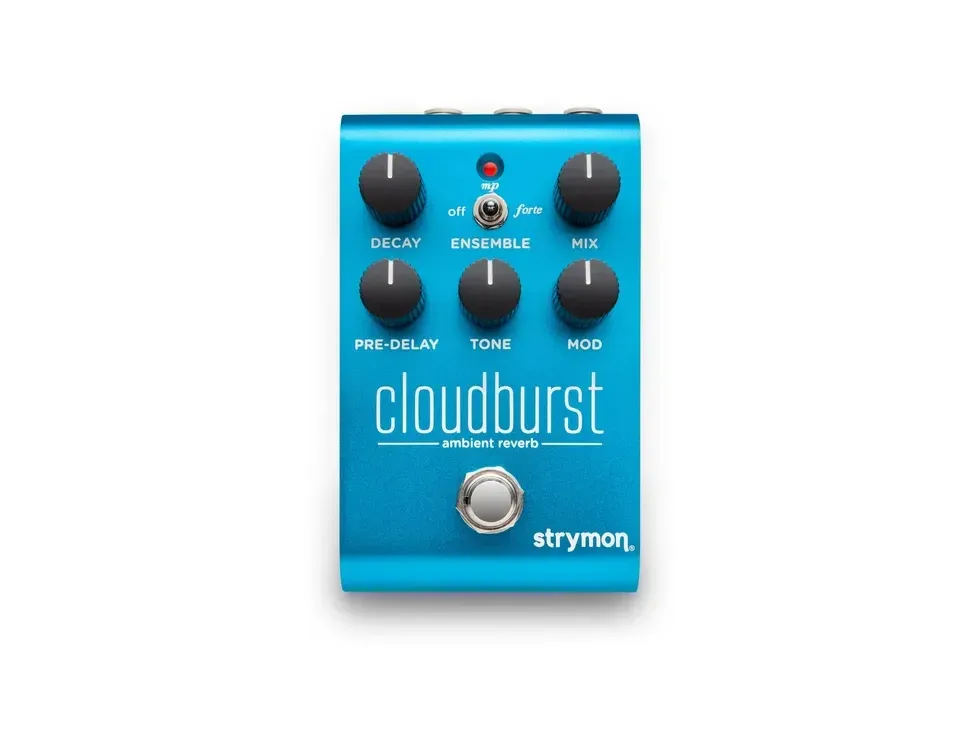Harmonizing ambient reverbs are tricky stuff. Tilt too much to the heavy-handed side and you can easily have a box of schmaltz on your hands. And from an operational standpoint, a lot of harmonizing reverbs tend to be complex and thick with secondary, hidden controls. That’s great for sound designers. Maybe less so for performing guitarists that would rather play and write than tinker with a pedal’s deeper secrets.
Strymon’s Cloudburst does a classy, clever job of inhabiting the simplicity side of the spectrum. It’s still deep and rich with ambient sounds that can stretch to extra-expansive. But it also produces very rich sound pictures of small spaces. And while it won’t effectively replace a spring sound—there’s a little too much harmonizing at most voices for that—it can be modest, a little lo-fi, imperfect, and less than pristine in really cool ways. With a WYSIWYG control set, it’s also a lot of fun to use in fast-moving, intuitive fashion.
Shrunken, Streamlined, Simple
Strymon pedals have taken on a few forms over their history. The near-uniform, relatively economical layouts of pedals like the Flint, El Capistan, and Deco, or bigger pedals like the BigSky or TimeLine, have an almost Boss-like way of engendering familiarity and ease. The Cloudburst feels every bit as inviting, and perhaps more so for its small size and relatively spare control array.
“Short decay, bright tone, spanky pre-delay, and a strong dose of mod, to simulate tape drift, can evoke skanky Exile on Main Street ambience.”
The controls are de rigueur for an ambient reverb. Mix, decay, pre-delay, tone, and modulation make up the knobs. A single toggle called “ensemble” switches between the three levels of harmonics that are added to the input signal: off, mezzo piano, or forte, which effectively increase the intensity of the harmonic effect
Each of the controls, and the pedal in general, have a lot of range, so you have to pay close attention to how the knobs relate to each other at very specific settings, with just a single preset at your disposal (called a “favorite” setting here), which unfortunately requires an outboard switch that can also be configured to work as a freeze switch (not included). If you have a MIDI controller, the pedal can be set up for 300 presets. The lack of many easily accessible presets is bound to turn off some users, and that’s a shame given the pedal’s range. But that makes it no less fun to work with on the fly, and the expression-pedal jack means you can create dramatic variations in mix level while you play. Cloudburst also comes with a full stereo TRS in/out, TRS MIDI, USB C and a discrete JFET front end.
Summon the Cumulus
The Cloudburst really can move through a lot of spaces, and many voices and capabilities will surprise. In the no-ensemble setting, and at a low mix level (as heard in Clip 1 of the audio included with the online version of this review), you get a taste of how rangy the Cloudburst can be in even small amounts. For starters, the pedal can offer a dollop of brightness and punch to a clean signal. Short decay, bright tone, spanky predelay, and a strong dose of mod, to simulate tape drift, can evoke skanky Exile on Main Street ambience, or a more controlled ’70s room environment. Stack on the decay time, a washy pre-decay, plus doses of tone and modulation, and you’re in ringing harmony-heavy surfgaze spaces. Advancing the mix just to noon significantly changes the size of the no-ensemble setting. And here, as heard in Clip 2, you’ll find much dreamier colors as you advance the mix.
One thing that’s cool about the mezzo piano and forte settings is that both modes can generate high-harmonic or orchestral textures that straddle the strange and organic. Depending on tone, modulation, and pre-delay settings, they can take on husky, almost dirty overtones or can be soft—almost like a synth with a slow attack setting. They can also easily be tuned to eliminate much of the cloying, hyper-angelic sound that colors other high harmonic reverbs, and can embellish simple melodies in very dramatic ways (Clip 3).
One thing that’s cool about the mezzo piano and forte settings is that both modes can generate high-harmonic or orchestral textures that straddle the strange and organic. Depending on tone, modulation, and pre-delay settings, they can take on husky, almost dirty overtones or can be soft—almost like a synth with a slow attack setting. They can also easily be tuned to eliminate much of the cloying, hyper-angelic sound that colors other high harmonic reverbs, and can embellish simple melodies in very dramatic ways (Clip 3).
The Verdict
Strymon’s simple but expansive Cloudburst pays a cost for its streamlined functionality and compact enclosure. Primarily, there are not enough presets for how many cool sounds there are here, unless you introduce other hardware and use MIDI. But that problem aside, Cloudburst is fun and stimulates musical thought. It’s also intuitive to use—as long as you’re willing to take the time to study the expansive ranges in the controls and get a sense for how interactive they can be. Still, even minor mastery of Cloudburst’s capabilities can open up opportunities and musical directions. At $279, it’s a pricey little machine. But it’s not hard to see getting many tunes, hooks, licks, and sparks of inspiration from the Cloudburst. And you can rack up a few hundred bucks worth of that stuff pretty quickly.

















